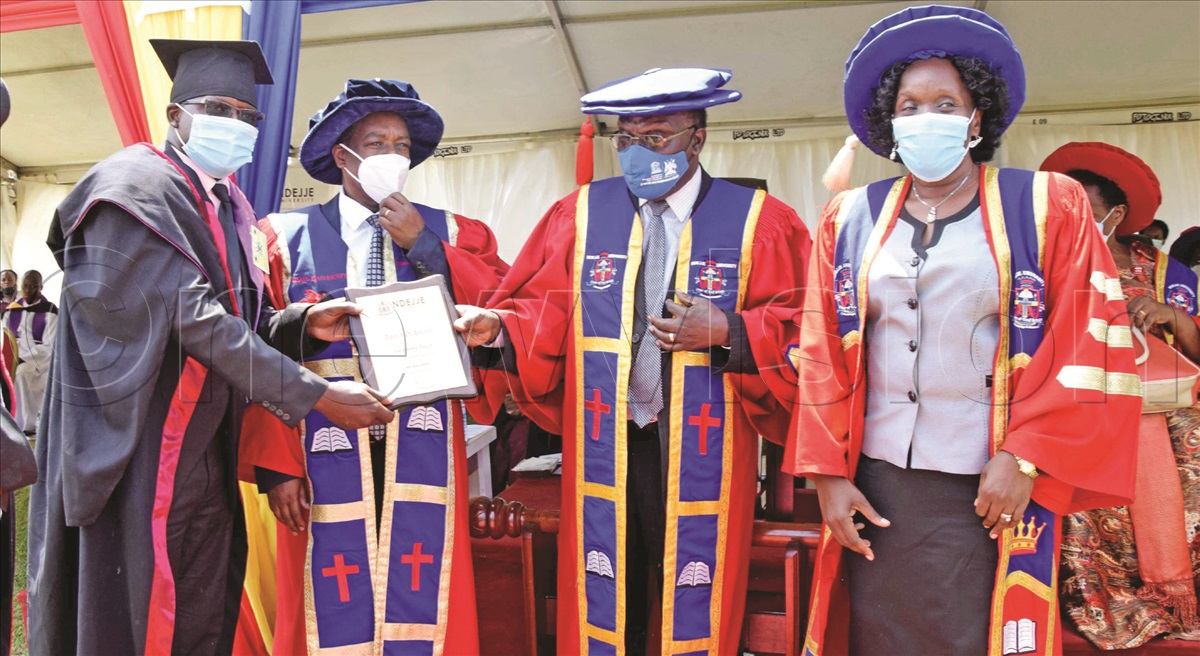This article was first published in the New Vision on March 10, 2021
By Conan Businge
Students who have been scampering for placement in the few medical schools, now have hope. The Government is in the process of helping a private university set up another medical school.
The Government is set to guarantee a loan request made by Ndejje University, of $22b (about sh82.2b); to set up a medical school and teaching hospital.
The plan was revealed by the vice-chancellor of Ndejje University, Prof. Eriabu Lugujjo, during the recent graduation ceremony.
He said: “By the mandate of the governing council, the university will set up requisite infrastructure for a fully-fledged medical school and start training health workers on a full spectrum next year.”
He added: “With the support of the First Lady and education minister Mrs Janet Museveni, whose team satisfactorily appraised the university’s capability to establish the medical school under appropriate financing arrangements. The infrastructure establishment will be backed by sovereign financial guarantee.”
At the event, Prof. Lugujjo was also asked to act as the chancellor, following the demise of Dr Kisamba Mugerwa, in January.
The guest of honour at the event was Ben Manyindo, the former boss of the Uganda National Bureau of Standards.
New Vision has established from sources in the finance ministry, that Mrs Janet Museveni wrote to finance minister Matia Kasaija requesting them to consider guaranteeing the university to acquire the loan facility in January.
Mrs Museveni, in the letter, noted that she had received another communication dated July 6, 2020, from the vice-chancellor of Ndejje University. In the letter, the university was seeking to revise the guarantee from $8.9m to $22m.
The university also intends to get the funds from China Exim Bank. The university, through Prof. Lugujjo, had written to Mrs Museveni asking her to revise the requested amount of money. The university had earlier requested to be guaranteed to borrow $8.9m, which Mrs Museveni had agreed with and requested the finance ministry to guarantee.
This amount, with a detailed explanation for a more-needs-and-ability-to-pay, the university mid last year asked the minister to raise the request to be guaranteed.
Prof. Lugujjo, in his February 2, 2021, letter explains that the education ministry agreed to raise the amount.
“After a further comprehensive evaluation of our request and satisfactorily assessed, our institutional capacity to undertake the proposed project with sovereign support,” he said.
In the January letter, Mrs Museveni said: “While I take note of the increase in the credit facility, I am also aware of the associated socioeconomic benefits of establishing of a medical school that is in line with the broader objective of the National Development Plan III. This is an addition to the fact that the university has demonstrated an impressive loan repayment record against the existing loan facilities advanced to it.”
Mrs Museveni said the issuance of a guarantee would enable the university enjoy a lower interest rate of less than 5% per annum, compared to the existing market rates which range between 20% and 25%.
“This will go a long way in reducing the debt burden of the university. Furthermore, repayment of the proposed credit facility shall commence more than five years from today, by which time the university will have cleared the current loan obligations.”
However, to get the guarantee, Mrs Museveni had to write to the finance minister, requesting for the guarantee of the loan, as required by the Public Finance Management Act 2015. Finance has already written to Ndejje University asking them to furnish them with documentation of heir financial transactions.

Is The Medical School Needed?
There is massive competition to be admitted to medical schools, the Joint Admissions Board of Universities. Only about 40% of the hundreds of students who apply to medical schools get vacancies in the 12 recognised medical schools in the country.
“Many students need credible medical schools, but they are still limited in the country,” the state minister for higher education, Dr John Chrysostom Muyingo, said.
According to the annual health sector performance report 2014/2015, Uganda had a total of 81,982 health workers employed in the country.
The number of medical doctors was estimated at 4,811, accounting for 6% of the total health workforce in the country. General practitioners (GPs) were estimated to total 3,993, the equivalent of 83% of medical doctors in service.
The consequences in Uganda are clear: the doctor to patient ratio was estimated at 1:24,725 in 2013, with a nurse to patient ratio of 1:11,000. The World Health Organisation (WHO) recommends one physician per 1,000 people.
Each year, about 320 medical students graduate from Ugandan universities, more than in any other East African state.
In the public health system, a doctor can expect to earn on average sh3m a month following an increase in their pay by the Government in this financial year.
Prof. Francis Omaswa, in a 2017 joint report with other experts, dubbed Brain drain to brain gain: Health workforce migration: A case study of general practitioners in Uganda, said there is need for local training of our medical practitioners. This is because, most of the time when they are trained from abroad, due to brain drain, they never come back to the country.
The majority of GPs in Uganda received their medical training from within Uganda (58%), with lesser proportions receiving training in North America (19%) and Europe (12%). Outside Uganda, North America and Europe, therefore account for the bulk of medical training (31%).
Between 2010 and 2015, out of 2,915 general practioners registered with the Uganda Medical and Dental Practitioners Council (UMDPC), 72 Ugandan nationals (2.5%) returned to Uganda from training abroad. This is equivalent to an average of 12 annually.
Over the study period, 38 foreign nationals (1.3%), or an average of six annually, were trained in Uganda and registered as general practioners. These came from 10 countries, mainly Somalia and Kenya, but also from as far afield as India, Islamic Republic of Iran, Mexico and Poland.

